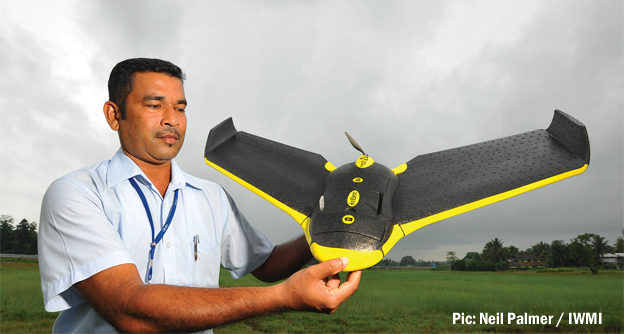-
Assessing the health of crops, observing flooded areas and analyzing water use on farms will all be made easier thanks to IWMI’s latest acquisition: a drone. The unmanned aerial vehicle, a Swiss-made Electronic Bee or eBee, caused quite a buzz during test flights over Anuradhapura in northern Sri Lanka. “When we got the first pictures back from the drone, we were delighted,” said Salman Siddiqui, Senior Manager of IWMI’s GIS, RS and Data Management Unit. “The detail and clarity were spectacular.”
The eBee carries a 16-megapixel camera, which takes images with a
resolution of up to 3 cm. For comparison, this is significantly better
than the 50-cm resolution of Google Earth images. The photographs
can be stitched together (in the same way as satellite images) to
produce a digital surface or elevation model in virtual 3D. However,
unlike with satellite images, cloud cover is not an issue, as the drone
flies below any clouds. Also, whereas satellite images can only be
recaptured every 15 or so days, IWMI’s scientists can dictate
the frequency at which they gather images using the eBee.

-
Operating the drone is simple. Ahead of each flight, the researchers
program in mission details, such as the area to cover, resolution and
other flight parameters. The drone then takes off, flies and lands
automatically, using a built-in artificial intelligence module and Global Positioning System (GPS). Each flight can last 45 minutes on a single charge, depending on the wind speed and altitude. Sensors keep the vehicle stable in flight, even if the wind changes, and help it to avoid other flying objects, such as birds and helicopters. If it starts to rain or the GPS signal is lost or contact with the base is broken, the drone returns to its starting location.
The first task for IWMI’s drone was to develop a high-resolution digital elevation model of Badulla, the capital city of Uva Province. The Survey Department of Sri Lanka needed the model to help develop a disaster mitigation plan for the city. Using conventional techniques, it might have taken longer than a year to survey the area. However, IWMI’s drone team was able to survey the entire 10-km2 area in just 3 days. During this time, the drone made 14 flights and shot 4,600 high-resolution images, with an average spatial resolution of 4 cm.
The drone is currently being used to help health planners monitor the spread of chronic kidney disease of unknown etiology (CKDu), which has been linked to contaminated well water. Meanwhile, a planned future initiative involves mapping freshwater springs in the watersheds of Nepal using a small thermal sensor. The watersheds in question have dense canopy cover, which makes it difficult to use standard optical sensors to locate springs. A drone-mounted thermal sensor can see through the vegetation and locate the waterways, which are colder than the surrounding earth.

